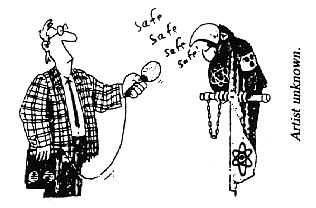Safe Radiation

 A lie I deal with:That “limited regulated releases” of radiation are safe.The BEIR report (Biological Effects of Ionizing Radiation) shows that there is no lower limit on radiation exposure that does not carry a negative health effect. All exposures to radiation, including medical and dental exposures, and natural background exposures, carry an epidemiological risk. Cumulatively they combine with other environmental factors and genetic factors to increase the risks of cancer, birth defects, mutations, and the general malaise and lack of disease resistance that are the primary effect of low dose radiation exposure. Nuclear regulatory agencies base their regulatory regimes on an antiquated philosophy of utilitarianism. Briefly, utilitarianism uses the greatest good for the greatest number as its criterion of value. First articulated in 1780 by Jeremy Bentham, there are a number of problems with this:1) The philosophy has generally been superseded by a human rights philosophy under which no individual should have the security of their person threatened.2) There is no real way to calculate and quantify the benefits and costs in applying the utilitarian philosophy to practical matters.3) In the particular matter of radiation, we can see that the distribution of costs and benefits is inequitable. That is, the costs, i.e. low dose exposures, from say, tritium from nuclear power plants, radon from mine tailings, as well as incidental exposures from higher dose sources throughout the industry, are distributed widely throughout populations generally at random. Those exposed are generally not able to decide if they want to be exposed or not. The benefits of nuclear enterprise, however, are concentrated to a much smaller population cohort, i.e. nuclear industry owners and employees, regulatory agency staff, militarists who rely on weapons, and so on, who are able to chose if they want to be in that group receiving the benefits.
A lie I deal with:That “limited regulated releases” of radiation are safe.The BEIR report (Biological Effects of Ionizing Radiation) shows that there is no lower limit on radiation exposure that does not carry a negative health effect. All exposures to radiation, including medical and dental exposures, and natural background exposures, carry an epidemiological risk. Cumulatively they combine with other environmental factors and genetic factors to increase the risks of cancer, birth defects, mutations, and the general malaise and lack of disease resistance that are the primary effect of low dose radiation exposure. Nuclear regulatory agencies base their regulatory regimes on an antiquated philosophy of utilitarianism. Briefly, utilitarianism uses the greatest good for the greatest number as its criterion of value. First articulated in 1780 by Jeremy Bentham, there are a number of problems with this:1) The philosophy has generally been superseded by a human rights philosophy under which no individual should have the security of their person threatened.2) There is no real way to calculate and quantify the benefits and costs in applying the utilitarian philosophy to practical matters.3) In the particular matter of radiation, we can see that the distribution of costs and benefits is inequitable. That is, the costs, i.e. low dose exposures, from say, tritium from nuclear power plants, radon from mine tailings, as well as incidental exposures from higher dose sources throughout the industry, are distributed widely throughout populations generally at random. Those exposed are generally not able to decide if they want to be exposed or not. The benefits of nuclear enterprise, however, are concentrated to a much smaller population cohort, i.e. nuclear industry owners and employees, regulatory agency staff, militarists who rely on weapons, and so on, who are able to chose if they want to be in that group receiving the benefits. In a nutshell, that is the lie. The use of the principles of “limited regulated releases” and exposures “as low as reasonably achievable” (the ALARA principle) by nuclear industry is not safe because it does not recognize that there is no exposure that is without risk, and that there is no ability among populations to choose not to be exposed.Sincerely:Philip Kienholz
In a nutshell, that is the lie. The use of the principles of “limited regulated releases” and exposures “as low as reasonably achievable” (the ALARA principle) by nuclear industry is not safe because it does not recognize that there is no exposure that is without risk, and that there is no ability among populations to choose not to be exposed.Sincerely:Philip Kienholz US born, Minnesota youth > Winnipeg, Manitoba, Canada during Vietnam war, architecture degree U of MB; Buddhist lay monk; Northwest Territories Dept Public Works and Services 1993 - 2011 managing construction projects. Retired architect, writer.
US born, Minnesota youth > Winnipeg, Manitoba, Canada during Vietnam war, architecture degree U of MB; Buddhist lay monk; Northwest Territories Dept Public Works and Services 1993 - 2011 managing construction projects. Retired architect, writer.